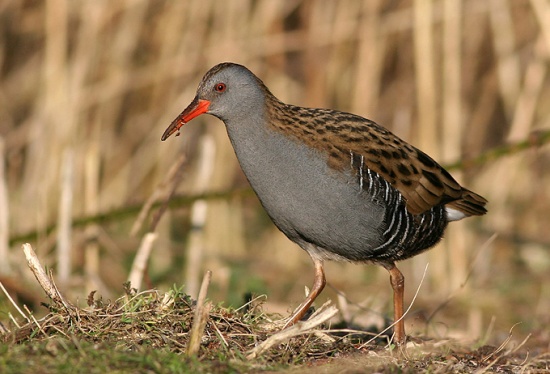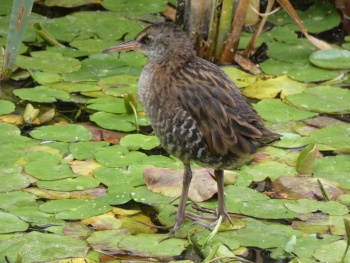- Rallus aquaticus
Identification
25–28 cm (9¾-11 in)
- Olive-brown upperparts, with broad, black streaks
- Grey face, breast and flanks
- Black-and-white barring on rear flanks
- Greyish supercilium.
Similar species
Brown-cheeked Rail is very similar, differing in browner, less grey cheeks and flanks; it can usually be separated on range, but overlaps locally with Water Rail on their wintering grounds in southern Asia. Young juvenile Common Moorhen is sometimes mistaken for Water Rail by novice birders.
Distribution
Breeds throughout most of Europe except for the northern half of Scandinavia; also western and central Asia, and northernmost Africa. Western and southern populations are resident, while northeastern birds are migratory. Winters mostly within the southern and western half of the breeding range but also more widely in north Africa and southwestern Asia, and a few reaching east to India and southeastern China.
Taxonomy
Brown-cheeked Rail used to be included in this species as a subspecies1.
Subspecies
There are three subspecies1, 2:
- R. a. hibernans:
- R. a. aquaticus:
- R. a. korejewi:
Habitat
Reedbeds, marshes, etc.
Behaviour
A skulker, this bird is much more often located by its piglet-like squeals.
Diet
Food includes both invertebrates and plant materials like seeds. Items eaten include worms, leeches, molluscs, shrimps, crayfish, spiders also many terrestrial and aquatic insects and their larvae.
Vocalisation
References
- Tavares, E. L. et al. (2010). Phylogenetic and coalescent analysis of three loci suggest that the Water Rail is divisible into two species, Rallus aquaticus and R. indicus. BMC Evolutionary Biology 10: 226.
- Clements, J. F., T. S. Schulenberg, M. J. Iliff, D. Roberson, T. A. Fredericks, B. L. Sullivan, and C. L. Wood. 2018. The eBird/Clements checklist of birds of the world: v2018. Downloaded from http://www.birds.cornell.edu/clementschecklist/download/
- Handbook of the Birds of the World Alive (retrieved July 2019)
Recommended Citation
- BirdForum Opus contributors. (2024) Water Rail. In: BirdForum, the forum for wild birds and birding. Retrieved 26 April 2024 from https://www.birdforum.net/opus/Water_Rail
External Links
GSearch checked for 2020 platform.1






